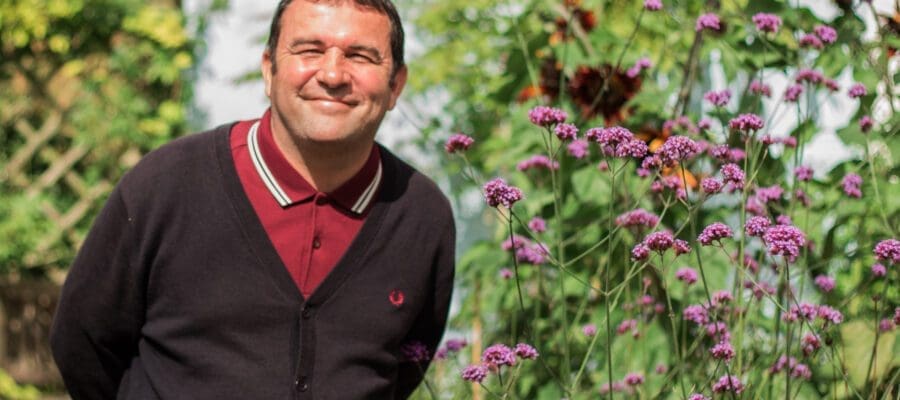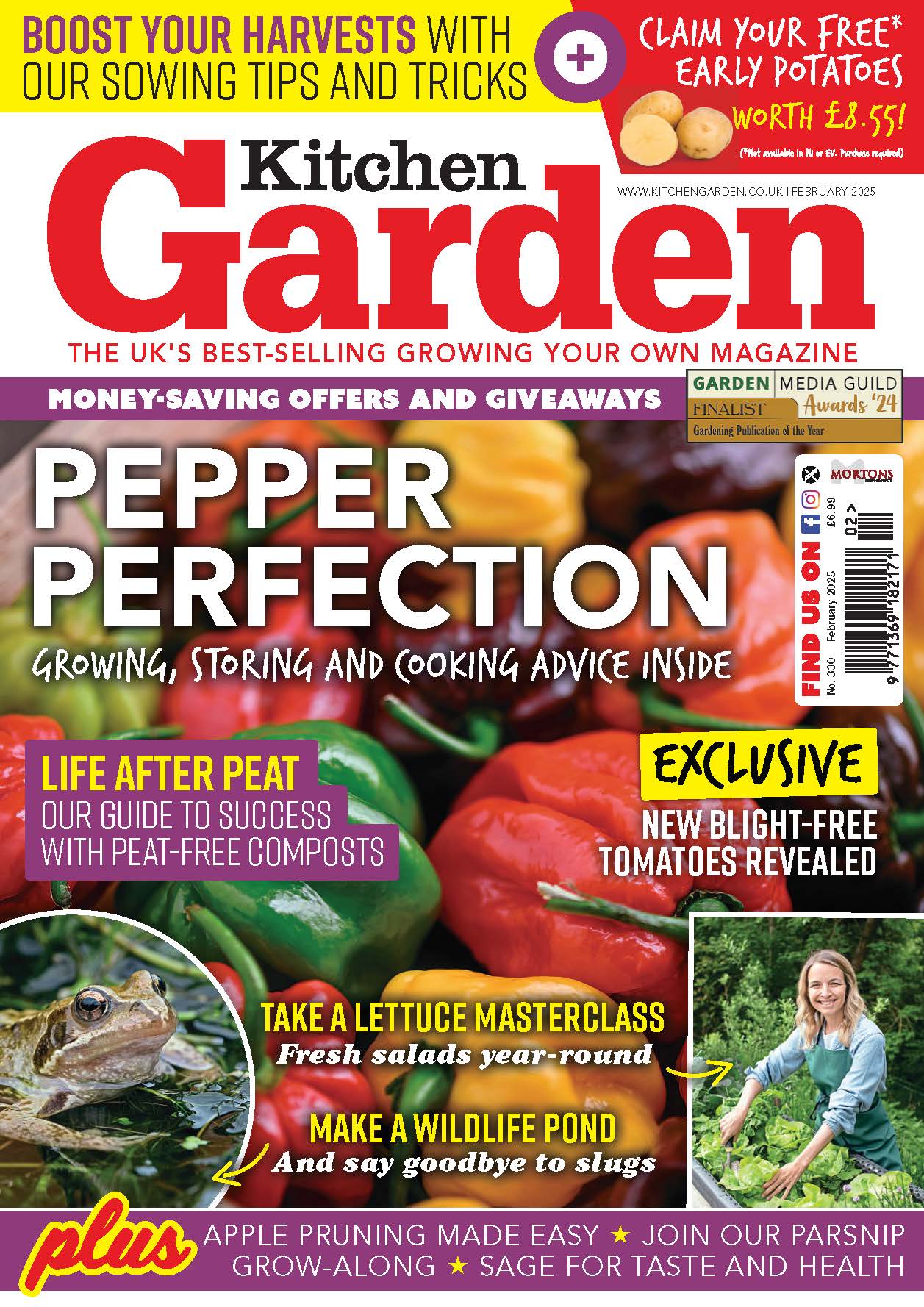Ex Blue Peter and Westminster Abbey gardener, Chris Collins, shares his top tips for starting out on your organic allotment journey during National Allotments Week (9 -15 August 2021).
Chris (now Head of Horticulture at charity Garden Organic) started his allotment journey three years ago when he took on the challenge of a large overgrown plot in Enfield, North London. The plot had been uncultivated for 5 years and was totally overgrown with couch grass, thistles, bindweed and horsetail. A grower’s nightmare.
The first job was to clear and prepare the ground without using artificial pesticides and fertilisers or machinery. Instead of being daunted by the task in hand Chris set out to tackle the new plot a section at a time.
Chris shares his experiences and advice for all new and existing allotment holders.
Tip 1 – start small
Chris said: “Newcomers to gardening and particularly allotments think they have to do everything all at once and get overwhelmed by the task in hand. This is not true; the best thing to do is tackle a new plot one section at a time.
“Save yourself a load of digging, by leaving some areas to look after themselves. Spread them with a thick layer of compost and then cover with cardboard or weed-suppressant matting (which can be purchased from garden centres) and put stones on top. After 6 months or so the soil will be perfect and the weeds will have died off. In the meantime, you can concentrate on planting in a smaller, more manageable section.
“Avoid using a rotavator as this will only chop weed roots into smaller pieces which will then multiply.”
Advice on how to clear your new allotment, using the No Dig technique can be found here
www.gardenorganic.org.uk/organic-allotment-growing
Tip 2 – produce your own compost
“Homemade compost is a must for any allotment holder,” says Chris. “Producing your own compost is free and you will have no need to buy expensive and potentially harmful chemical fertilisers or bagged compost for your garden.
“I always establish 3 compost bays or bins. The first for my fresh compost, the second to move the compost on as it becomes established and the third for leaf mould. Compost should be 50/50 greens (such as vegetable peelings and lawn clippings) and browns (such as screwed up cardboard and paper and chopped up woody prunings). I like to create ‘hot’ compost so I turn it regularly with my hands to get the aerobic action started. I also water it if it’s looking too dry.”
You can check out more information on making your own compost at: www.gardenorganic.org.uk/compost
Tip 3 – make your own organic plant feed
“I often use a water butt to make my own nutrient feeds. It’s so simple to soak nettles and comfrey leaves to get great liquid fertilisers – for free! Comfrey leaves are also great to add to the compost heap – the Bocking 14 variety is best to have on your allotment as the plant doesn’t spread. Making your own plant feed is a good way to garden sustainably, using nature’s own solutions, and it avoids plastic packaging and transport miles.
“I only use bought fertilisers if they are organic. I use the organic ‘Chase Seaweed Meal’ as this breaks down in the soil really well and I use a seaweed extract as a plant tonic – but this should only be used on plants with 6 or more leaves. I spray it every couple of weeks, early in morning when there is no wind. Sometimes I also buy comfrey pellets to put around my plants if they need an extra boost.”
See here www.gardenorganic.org.uk/comfrey on how to grow comfrey and make comfrey liquid feed.
Tip 4 – raise your food from seed and plant pollinator corridors
Chris said: “I enjoy the challenge of raising all my crops from seed. It also saves a lot of money. I always recommend buying organic seeds where possible (try www.organiccatalogue.com.)
“I don’t have a green house on my allotment. So I use propagators and peat free compost to start off my seeds at home.
“I’m always careful to make sure my seedlings are strong healthy plants before putting them out on the allotment – young sappy or weak plants are far more susceptible to diseases or attack from pests like slugs and snails. Planting out too early, and suffering a devastating slug attack, is what often tempts gardeners to reach for the toxic chemical pellets and sprays.
“I also love to grow potatoes and always use seed potatoes as they provide a stronger start. I stagger their lines as potatoes produce a thick leaf canopy and their overlapping leaves are good at blocking out light below so fewer weeds have a chance to develop.
“Alongside my edibles I always sow strips of hardy annual plants (Cornflower, Calandula, Helianthus, Nasturtium) and plant summer flowering bulbs, these give the whole plot a colourful lift and encourage the Bees, Hoverflies and Ladybirds.”
Need help with seed sowing? See Garden Organic’s advice on successful seed sowing tips www.gardenorganic.org.uk/six-steps-successful-seed-sowing
Tip 5 – grow green manures
“Finally, at the end of the growing season I love to plant green manures,” says Chris. “These are plants which are actually good for your soil. It’s a win, win. I use mustard seeds or field beans as their roots break up any heavy clay soil. The beans will also capture vital nitrogen into the soil. Just be sure to dig them in before flowering, so you don’t lose the benefit. Organic growing is all about building a healthy soil, full of nutrients and with a good structure.”
Help on how to use green manures is here www.gardenorganic.org.uk/green-manures
“I love working on my allotment. It keeps me fit and healthy, both physically and mentally; it saves me money; and it cuts down on unnecessary food miles. But most importantly, by gardening organically I am doing my bit to protect the environment and encourage wildlife. My organic allotment is a natural haven in the middle of our busy capital”.
For further hints and tips about growing your own food in an environmentally and healthy way visit www.gardenorganic.co.uk

Before 
After





